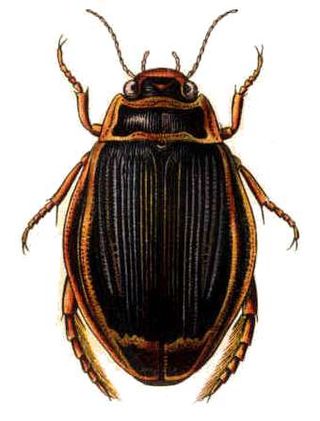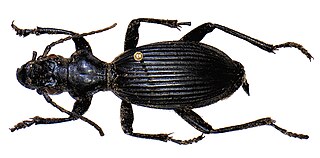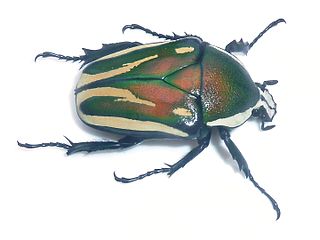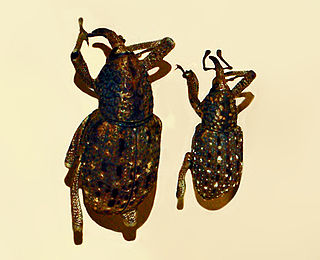| Diplognatha | |
|---|---|
 | |
| Diplognatha gagates from Guinea-Bissau | |
| Scientific classification | |
| Kingdom: | |
| Phylum: | |
| Class: | |
| Family: | |
| Subfamily: | |
| Genus: | Diplognatha |
Diplognatha is a genus of beetle belonging to the family Scarabaeidae, Cetoniinae subfamily.
| Diplognatha | |
|---|---|
 | |
| Diplognatha gagates from Guinea-Bissau | |
| Scientific classification | |
| Kingdom: | |
| Phylum: | |
| Class: | |
| Family: | |
| Subfamily: | |
| Genus: | Diplognatha |
Diplognatha is a genus of beetle belonging to the family Scarabaeidae, Cetoniinae subfamily.
Species of this genus are of medium size (approx. 20–27 mm). The body is slightly oblong and flat, with a shiny surface, usually black or brown, but some species have a distinct metallic sheen. A sexual dimorphism is barely visible. The larvae usually live in the soil, but some species are supposed to develop in bird and bee nests. In some species, the adult beetles live for several years, which is relatively uncommon.
These beetles live in tropical Africa. The species Diplognatha gagates is found almost everywhere in Africa south of Sahara.



Tiger beetles are a family of beetles, Cicindelidae, known for their aggressive predatory habits and running speed. The fastest known species of tiger beetle, Rivacindela hudsoni, can run at a speed of 9 km/h, or about 125 body lengths per second. As of 2005, about 2,600 species and subspecies were known, with the richest diversity in the Oriental (Indo-Malayan) region, followed by the Neotropics. While historically treated as a subfamily of ground beetles (Carabidae) under the name Cicindelinae, several studies since 2020 indicated that they should be treated as a family, the Cicindelidae, which are a sister group to Carabidae within the Adephaga.

Dytiscus is a Holarctic genus of predaceous diving beetles that usually live in wetlands and ponds. There are 26 species in this genus distributed in Europe, Asia, North Africa and North and Central America. They are predators that can reduce mosquito larvae.

Anthia is a genus of the ground beetle family (Carabidae) from Africa and Asia. Species of Anthia can spray a jet of formic acid up to 30 centimetres (12 in), which, if not treated, can cause blindness in animals that harass the beetles.

The Trichiini are a tribe of the scarab beetle family (Scarabaeidae), though historically they were often classified as a subfamily, Trichiinae. The conspicuous bee beetles (Trichius) are probably the best-known genus in Europe.

Flower chafers are a group of scarab beetles comprising the subfamily Cetoniinae. Many species are diurnal and visit flowers for pollen and nectar, or to browse on the petals. Some species also feed on fruit. The group is also called fruit and flower chafers, flower beetles and flower scarabs. There are around 4,000 species, many of them still undescribed.

Aphodius is a genus of beetles in the family Scarabaeidae. In most species both the adults and larvae are coprophagous although some species have herbivorous or saprophagous larvae. Aphodius species typically dominate dung beetle communities in north temperate ecosystems. Most species are functionally classified as endocoprids, also known as dwellers, because the larvae live and feed within the dung pat itself.

Heliocopris is a genus of Scarabaeidae or scarab beetles in the superfamily Scarabaeoidea. Forty-seven of the fifty-two known species are found in Africa, but a few are found in southern and southeast Asia.

Tefflus is a genus of large, black and flightless Afrotropical ground beetles in the tribe Panagaeini. They are broadly similar to the Anthiini ('oogpisters'), but are not colourful, and have a six-sided and flattish pronotum. The distinct longitudinal carinae (ridges) on their elytra are separated by two rows of punctures running along the striae (grooves). Males have some segments of the forelegs enlarged.

Arthropterus is a genus in the beetle family Carabidae. There are more than 60 described species in Arthropterus, found in Australia.

Dicronorhina derbyana, or Derby's flower beetle, is a sub-Saharan species of flower chafer.

Stephanorrhina is a genus of the family Scarabaeidae, subfamily Cetoniinae and tribe Goliathini.

Coelorrhina is a genus of flower chafers.

Diplognatha gagates is a species of beetle belonging to the family Scarabaeidae, Cetoniinae subfamily.

Gnathocera is a genus of beetles belonging to the family Scarabaeidae.

Taurhina is a genus of beetle belonging to the family Scarabaeidae. The name is frequently misspelled as Taurrhina following an unjustified spelling change by Kraatz in 1890.

Sipalinus is a genus of beetles belonging to the family Curculionidae.

Eudicella is a genus of small to medium beetles in the subfamily Cetoniinae, belonging to the wider family Scarabaeidae. They are distributed throughout the Afrotropical realm, including South Africa, Rwanda and Zimbabwe.

Compsocephalus is a genus of flower chafers belonging to the family Scarabaeidae, subfamily Cetoniinae. These beetles are most commonly found in East Africa, more specifically Kenya.

Euporus is a genus of beetles belonging to the large subfamily Cerambycinae in the family of longhorn beetles (Cerambycidae).
Phoberus is a genus of hide beetle in the subfamily Troginae. It was initially a subgenus of Trox before taxonomists reorganized it into its own genus. The genus is monophyletic, with all species evolved from a single common ancestor. Most beetle species in the genus live in Africa.